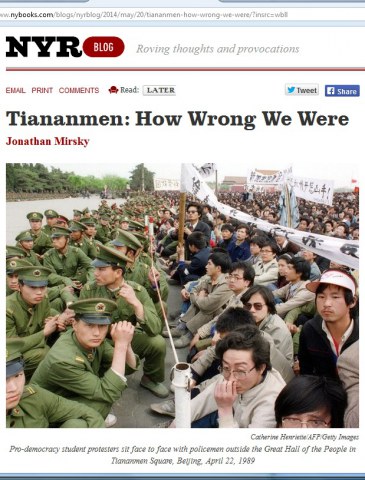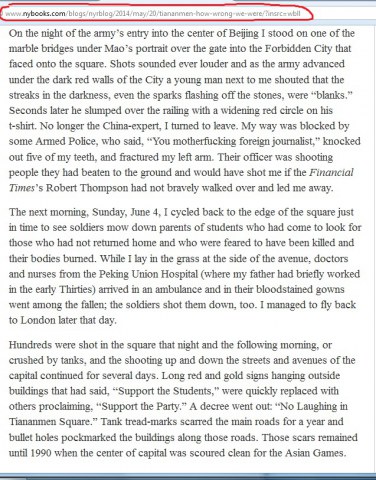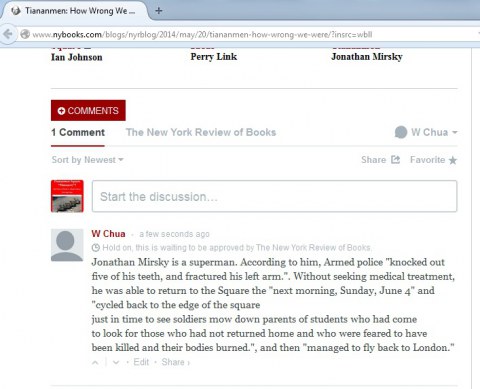This is an exercise for the public to learn how to distinguish between honest journalism and agenda based writing. Below is an embedded screenshot of an article on The New York Review of books (20 May, 2014) title ‘Tiananmen: How Wrong we Were’ by Jonathan Mirsky. (see screenshot evidence: attachment 1)
There are a number of common sense flaws (lack of logic) in the following report that allow people to tell that the author was making up the story. Can you detect those flaws. I left a short comment to point out one of the most prominent flaws, and was deleted minutes later. Before you check for the answer at the bottom of this article, please read this screenshot from the article, and try to identify the flaws yourself to see how good a detective you are (see screenshot evidence: attachment 2):
Detect the flaws:
For your convenience I have reproduced the content of screenshot 2 below:
On the night of the army’s entry into the center of Beijing I stood on one of the marble bridges under Mao’s portrait over the gate into the Forbidden City that faced onto the square. Shots sounded ever louder and as the army advanced under the dark red walls of the City a young man next to me shouted that the streaks in the darkness, even the sparks flashing off the stones, were “blanks.” Seconds later he slumped over the railing with a widening red circle on his t-shirt. No longer the China-expert, I turned to leave. My way was blocked by some Armed Police, who said, “You motherfucking foreign journalist,” knocked out five of my teeth, and fractured my left arm. Their officer was shooting people they had beaten to the ground and would have shot me if the Financial Times’s Robert Thompson had not bravely walked over and led me away.
The next morning, Sunday, June 4, I cycled back to the edge of the square just in time to see soldiers mow down parents of students who had come to look for those who had not returned home and who were feared to have been killed and their bodies burned. While I lay in the grass at the side of the avenue, doctors and nurses from the Peking Union Hospital (where my father had briefly worked in the early Thirties) arrived in an ambulance and in their bloodstained gowns went among the fallen; the soldiers shot them down, too. I managed to fly back to London later that day.
Hundreds were shot in the square that night and the following morning, or crushed by tanks, and the shooting up and down the streets and avenues of the capital continued for several days. Long red and gold signs hanging outside buildings that had said, “Support the Students,” were quickly replaced with others proclaiming, “Support the Party.” A decree went out: “No Laughing in Tiananmen Square.” Tank tread-marks scarred the main roads for a year and bullet holes pockmarked the buildings along those roads. Those scars remained until 1990 when the center of capital was scoured clean for the Asian Games.
Write your answers on a piece of paper and compare with the answers below:
-
-
-
-
Answers
Flaw 1:
The following is the content of my comment deleted wtihin minutes by the New York Review of Books (see screenshot evidence 3):
Jonathan Mirsky is a superman. According to him, armed police "knocked out five of his teeth, and fractured his left arm." Without seeking medical treatment, he was able to return to the Square the "next morning, Sunday, June 4" and "cycled backed to the edge of the square just in time to see soldiers mow down parents of students who had come to look for those who had not returned home and who were feared to have been killed and their bodies burned," and then "managed to fly back to London."
Flaw 2:
This statement: “knocked out five of my teeth, and fractured my left arm. Their officer was shooting people they had beaten to the ground and would have shot me if the Financial Times’s Robert Thompson had not bravely walked over and led me away.” places the author and the Financial Times’s Robert Thompson as firsthand witness of killing right in front of them. However, not only the article fails to produce a single image of death people, or at least a photo evidence of the author own 5 broken teeth, the photo that displays in the article is an image of unarmed soldiers facing a group of protesters. (see screenshot 1)
Flaw 3:
From the article, we learn that the author “managed to fly back to London later that day" (4 June, 1989), however, he continues to describe in detail the mass shooting and killing over a period of “several days” in his absence.
Welcome to the real world!
This is very typical of the mainstream western media. Read this recent article as well to learn about how the BBC journalist describes a massacre and an indiscriminate shooting of “unarmed” and “peaceful” protesters for hours right in front of her in 1989 without the needs to show her viewers a single clip of a death person.
By Wei Ling Chua
Author of this 270 page Amazon book: Tiananmen Square “Massacre”? The Power of words vs. Silent Evidence
Accredited International News Syndicate and Australia News and Feature Services freelance journalist.
Blog: www.outcastjournalist.com
Like us on Facebook: https://www.facebook.com/mediadisinformation
Follow us on Twitter: https://twitter.com/OcastJournalist
Alert me with more story: wchua62@gmail.com



